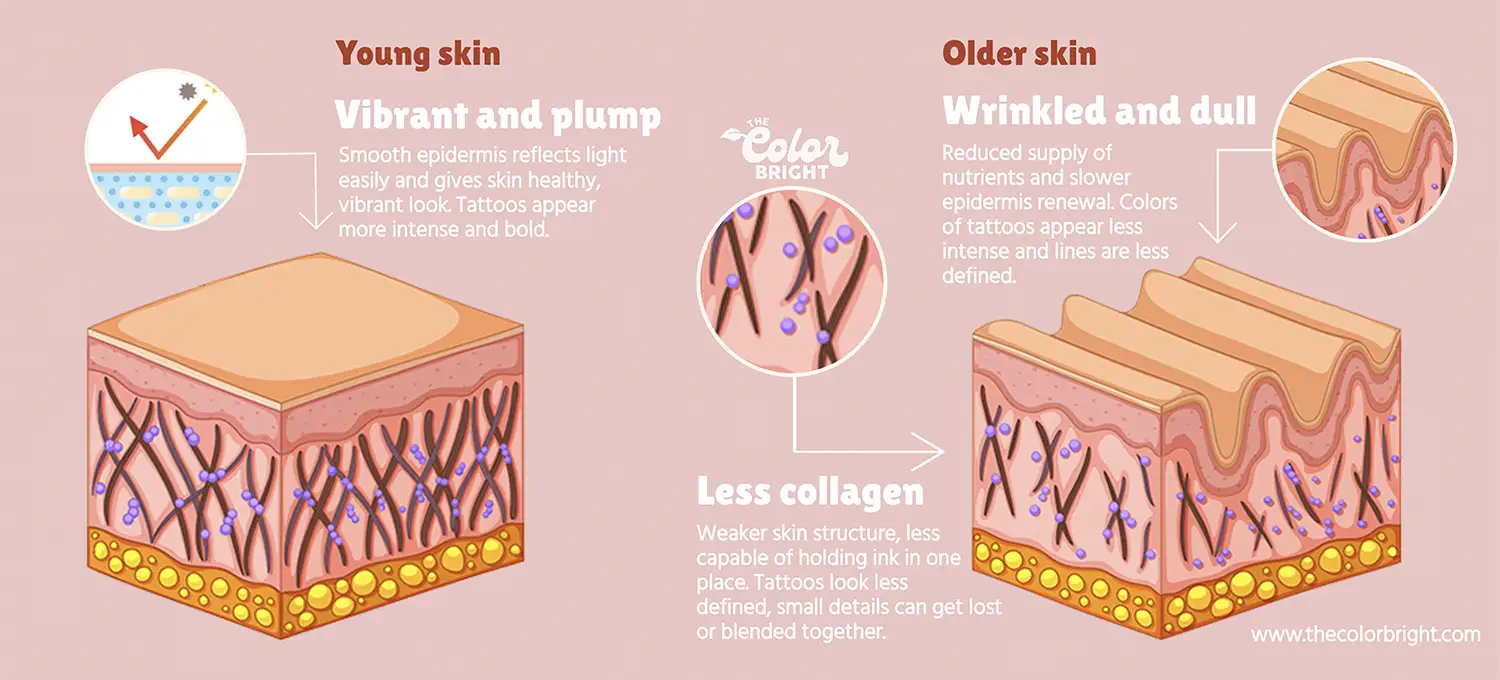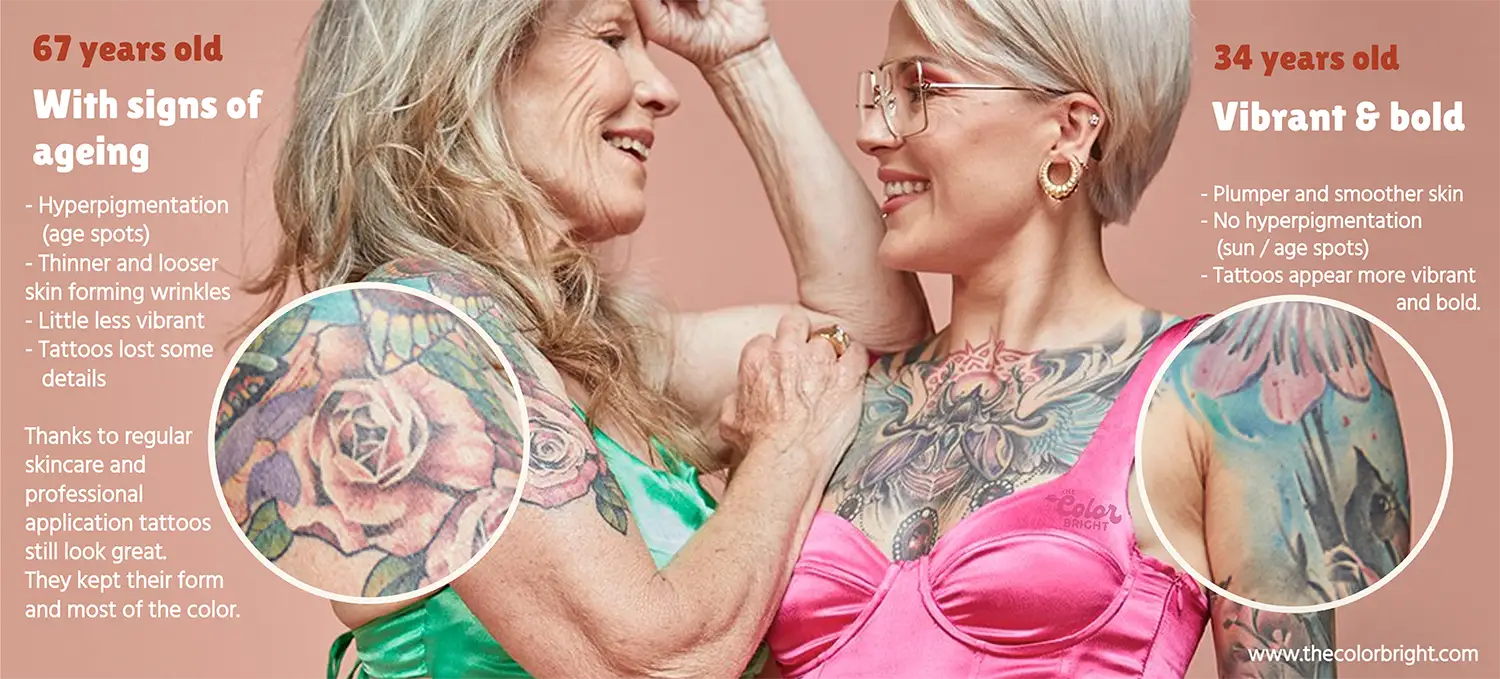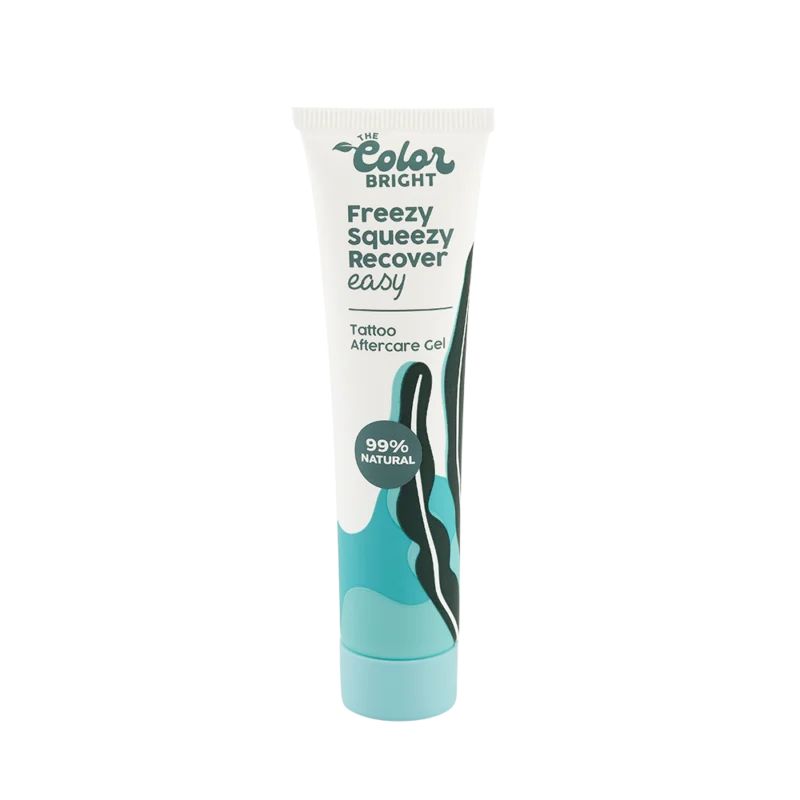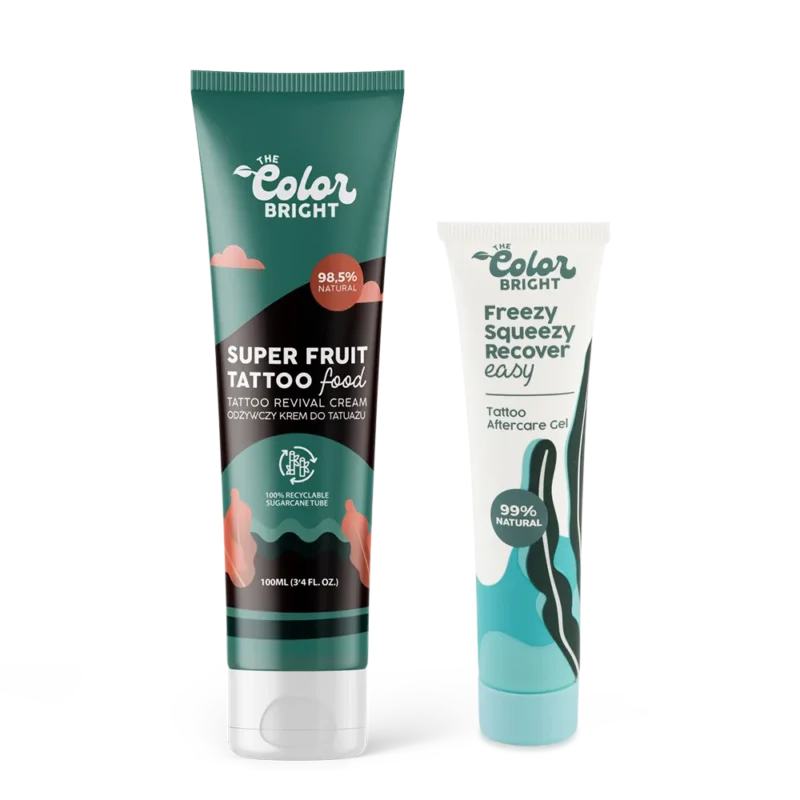Many worry about how their tattoos will look when they get older. We worry about tattoo ageing but do we know why tattoos fade? What causes the tattoo ageing process, and is there a way to keep tattoos bright and bold even on older skin?
- Natural factors causing skin ageing and tattoo fade
- Other things that contribute to tattoo ageing
- What can you do to avoid faded tattoos on older (and younger) skin
1. Why tattoos fade – Natural factors causing tattoo ageing.
Let’s start with the basics of how our skin is built. To make it easier, we will focus only on the two main skin layers most important in tattoo ageing.
The two layers are;
- Epidermis – The top layer of the skin that provides a waterproof barrier and creates our skin tone.
- Dermis – This is where tattoos are located. It is the most stable and, therefore, capable of holding tattoo ink.
When we are young, the epidermis (top layer) is smooth and thin, and the dermis ( second layer) is thick and firm, giving our skin that plump, vibrant look. But with age, these proportions start to flip.
Tattoo ink stays liquid and moves around
Around the age of 30, the production of collagen and elastin, the main building blocks of the skin, slows down, and that formerly thick and firm layer of skin becomes thinner and weaker in its structure.
It affects not only the firmness and elasticity of our skin but also the tattoo.
A diminishing supply of essential building substances in the dermis causes ink molecules to ‘loosen’.
It is easiest to spot by looking at tattoos with many details, e.g. thin lines. Initially, bold, clean and evenly spaced lines begin to ‘spread’’. They become thicker, less sharp, and in worse cases, they may merge.
Wrinkled tattoos
On the other hand, the thin and smooth epidermis (1st skin layer) weakens and begins to form wrinkles.
Dull, faded tattoos
The skin renewal process slows down, and as a result, the topmost layer of the epidermis (the stratum corneum) gets thicker.
Thicker stratum corneum blocks the light from going through and reflecting from the skin, as a result, the skin starts to look matt and dull.
Guess how that dull skin sitting on top of the tattoo makes them look? Less vibrant, less lively and less intense.
Fewer nutrients for skin cells that hold your ink
Another issue is caused by the separation of the two skin layers.
The epidermis (upper layer) doesn’t have a blood supply and receives nutrients from the layer below (the dermis).
The changes I mentioned before significantly limit the flow of nutrients from the dermis to the epidermis. As a result, the less nourished top layer of skin covering the tattoo distorts its appearance even more.
We can not completely stop the natural skin ageing processes (at least not at this moment), but we already know how to significantly slow down this process and reduce skin and tattoo ageing. More about this later in the article.

2. Other things that contribute to tattoo ageing
Our choices can also influence how our tattoos age and how we and our tattoos will look when we get old.
Natural ageing causes are one thing, but your decisions can also largely influence how you will look as an old person with tattoos.
Those choices are:
Choosing the right tattoo artist
Choosing the right artist is critical because not every tattooer is equal. In most countries, you do not need to undergo special training, pass exams or get a degree. In reality, everyone with access to tattooing equipment can become a tattooer. It is up to us to decide if we do proper research and properly check the work and experience of a particular tattoo artist or not.
Experienced artists use appropriate tattooing techniques for the style and the placement on the body you want to tattoo. They will also refuse to tattoo you if they decide your idea for a tattoo will not age well.
A reputable artist will guide you through the aftercare process and help you troubleshoot if any issues arise. Therefore, if you want your tattoo to look great after being done but also on older skin, choose a tattooer you trust.
Placement on the body
Skins’ thickness is different on different body parts. Just compare the skin on your forearm with the skin on your hand. They are beside each other, but the difference in thickness is significant.
Contrary to popular belief, tattoos on such risky spots as lips, ears, feet, hands, and fingers can be done right.
I am a living example of that. After five years, my hand and finger tattoos show no signs of fading, But to achieve that, you need an artist with knowledge, experience and appropriate technique.
The internet is full of photos of tattooed hands, fingers, or lips that faded quickly after being done.
So choose wisely and don’t be pushing for that realistic portrait of a lion on your finger unless you know the consequences. Even the best tattooer in the world won’t be able to make it last. A tattoo like this, sooner or later, will start to fade; it’s just the biology of our bodies.
The style of tattooing
These days we can tattoo the same tattoo idea in all different styles. Thanks to
Nowadays, we can tattoo the same subject or idea in many different styles. Thanks to technology development, tattoo artists can access better inks, machines, needles, etc. This enables them to experiment with different techniques and styles of tattooing. It also allows for better and more precise ink application. They can create more solid tattoos and therefore make them age better. However, some styles will change faster over time than others.
A traditional tattoo, for example, has thicker black lines, fewer details, simpler and more saturated colors, and a lot of black, making it almost indestructible. We know this because it is one of the oldest popular tattooing styles, and many older people with traditional tattoos have aged very well.
In contrast, we have a watercolour tattooing style, for example, with many bright colors, without black lines that would ‘’keep the tattoo together’’. This makes them less durable and more prone to fading especially on darker skin tones.
Bright colors, especially white and yellow, change their shade under the influence of melanin in our skin (a substance that makes you tan). The melanin layer is located just above the tattoo, and if your skin is darker than the ink, it will apply a dark filter to the tattoo beneath. Like lenses in sunglasses, they change the colors of everything you look at.
An experienced tattoo artist should match the colors used in your tattoo to the color of your skin and draw your attention to the importance of protecting the tattoo from the sun.
Tattoo size and details
Many people do not give much attention to the size of the tattoo, but it is very important in the tattoo ageing process. Small tattoos can change more with time, especially those with many details.
The ink in the skin remains in liquid form, and the ink molecules are encapsulated in cells called macrophages. With age, skin becomes looser and so are the tattoos. Ink moves and spreads.
It is easy to observe in very detailed tattoos. Initially, crisp, clear and evenly spaced lines begin to ‘’spread’’, they become thicker and less pronounced. If they are too close to one another, they can merge, making your tattoo very difficult to read.
There is also a process of ink capture – release – recapture when old macrophages die and new cells take over the ink, but more on that in another article.
So chose an excellent, trusted tattoo artist. Listen to them if they tell you that the size you selected is too small. They are not saying it to make you pay for an extended, more expensive session but to protect you from wearing hard-to-read, blurred tattoo when you get older.

3. How to makesure that tattoos will look good even on older skin?
Well… look after your skin!
During the tattooing session
It is good to start looking after your tattoo as early as during your tattooing session.
Again, I cannot stress the importance of choosing a great tattoo artist.
Good artists use good products because they know they help them achieve great results. There are good products that reduce bleeding, for example, which helps in better ink application. Bleeding is a normal thing during the tattooing session, but if for some reason you bleed too much, your body will push out the ink that your artist has just applied to your skin.
Excessive bleeding may be caused by painkillers, alcohol or even coffee, so always consult your tattooer before taking anything before or during your tattooing session.
It is crazy to think that even such small details can affect how your tattoo looks right after healing and when you get old.
Tattoo aftercare / Tattoo healing
Follow the tattoo aftercare procedure explained by the tattoo artist. Don’t listen to your friends or the internet. Tattooers know best how to heal their work, and it was them who worked on your skin, not some random dude from a Facebook group.
A good tattoo studio or tattooer knows the best tattoo healing products and recommends one that will speed up the tattoo healing process.

Daily Tattoo Care
It is good practice to start a daily tattoo care routine right after your tattoo is healed.
Products such as Tattoo Revival Cream are formulated specifically to slow down tattoo ageing and fading. Tattoo care products applied daily will keep skin in great condition, and healthy skin combined with well-done tattoos create artwork that will still look amazing when you get old.

Tattoo Sun Protection
Tattoo sunscreen is a must if you want to avoid tattoo fading. Sun and UV rays are one of the biggest factors contributing to skin ageing and tattoo fading. There are two main reasons why:
- Under the influence of the UV rays, our body starts producing melanin (tan) that protects skin from burning. The melanin layer is located just above the tattoo so it creates a dark filter on top of the ink; the darker the skin gets, the more it distorts the colors of the tattoo. Blue can look more greenish and white more yellowish or orange.
Luckily as the tan goes away, the tattoo returns to its previous shades. However, the following process I am about to explain is irreversible…
- UV rays work similarly to laser tattoo removal. They break ink particles into smaller pieces that are easier to digest and remove from the body. Sunburns further intensify this process. Therefore, the sun can permanently damage and cause the tattoo to fade faster, so sunscreen on your tattoos is a must. SPF 30, which blocks 97% of UV rays, is sufficient to protect your tattoos.
The good news is that old people with tattoos can look amazing!
If you choose the right artist, placement and style and then follow the right tattoo skincare routine, you have a very good chance to enjoy healthier more radiant skin and beautiful tattoos when you get old.
Remember that tattoo is an investment. You are investing in yourself, so make sure you do it wisely!
Love xoxo
Silvia



0 Comments